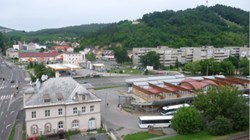Hungary
Vision underpinning the plan
The city has many challenges after the transition due to the change in economic conditions and the reduction of the population. Sustainable urban planning is important because it is a tool toward a more liveable city. The drafting of the SUMP has started with the BUMP project technical support to promote sustainable transport and mobility in the city, especially public transport (rail network, intermodal center) by integrated network development and improved service quality to have a liveable, socially sensitive and dynamic city.


Long-term strategic objectives
The drafting of the SUMP has started with the BUMP project technical support.
The overall goal is to promote sustainable transport and mobility in the city, especially public transport (rail network, intermodal center) by integrated network development and improved service quality to have a liveable, socially sensitive and dynamic city.
Mid-term goals
Improving the network of public transport, especially the local bus network
Improving the service quality and the data base for efficient sustainable mobility
Integrating and promotion of bike and walking lanes into the current city transport network
Improving the transport information system for the public
Increasing liveable public spaces.
Specific indicators
- Reduction in fuel consumption (litres): depending on the infrastructure development, the financial resources and the increase of the public transport needs
- The CO2 reduction has national target, 20% till 2020 (basic year is 1990). The transport share is about 40%.
- The NOx and PM10 emission reduction is according to the WHO standards and the national /local environmental protection target. (NOx/ PM10 40 µg/m3/year
- Investments connected to the SUMP - EU TOP resources: a. The intermodal center planning and implementation require EU TOP resources. b. The creation of efficient public transport data base require EU support.
- Road victims reduction target is according to the WHO target, which is adapted to the national conditions (app. 90%, 2020).
Main implementation features
Context analysis
The first context analysis gave the overall/specific goal, based on the current data. There is a need of the integrated data base for SUMP planning.
Measures to secure horizontal and vertical integration and participation of all main stakeholders
The stakeholder involvement is important for a comprehensive publically accepted planning. The stakeholders’ forums will be organized to discuss the measures and integrations.
Measures to foster a balanced development of all means of transport
The mid-term plan focus on bus network, the long-term plan on the rail network and inter-modality center and measures.
Other key points
New way of planning, stakeholders involved
The city is for people who can use different, integrated transport modes (citizens)
Chance to receive funds for the improvement of the city (municipal).